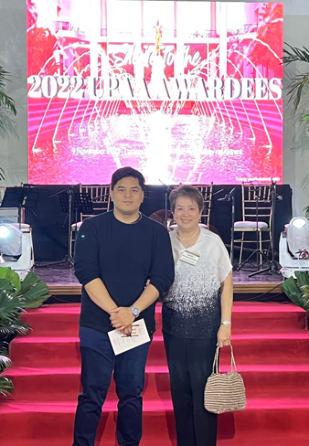






















JEEPNEY PRESS welcomes articles of interest on Filipinos in Japan. Please email any photos, drawings, and other materials that you would like to accompany the article. Submissions can also be sent by postmail. Photos, drawings and other materials will not be returned unless sent with a self-addressed, stamped envelope. Deadline is one month before publication. We reserve the right to edit or omit any submissions.
Disclaimer: Jeepney Press is not responsible for the transactions between its advertisers and their clients. Publisher does not endorse or make any representation or warranty, express or implied, with respect to any of the products or services advertised herein. We recommend that you independently evaluate all products/services before purchasing. Jeepney Press is not accountable for any claims on the articles in this magazine. They are purely the writer's idea and opinion. The views expressed herein are not necessarily representative of those of the publishers'. Public and private parties approached by those claiming to work for or on behalf of Jeepney Press should call our office to confirm truth of any such claim, especially where money may be involved.
Jeepney Press is published online bimonthly by Asia Vox Ltd.
All rights reserved. Copyright 2022 Asia Vox Ltd.






Yesterday, I was a guest lecturer for a Business Japanese class at Funabori Tower Hall in Edogawa, Tokyo. I gave a 2-hour presentation alternately speaking in both Japanese and English to foreign residents.
It was a very rich Japan when I first arrived here. The economy then was at its glorious peak. The economy has since slumped several decades later. And with the pandemic, inflation, and what is happening to our world now, everything looks so bleak...even for this rich country. I talked about how I survived and struggled in this foreign land and how I got to where I am today. Anyhow, once the presentation was over, they honored me with a long-standing ovation. I wasn't expecting it as I didn't give any musical concert of sorts. It was just a raw, simple but funny lecture about me, my life, and my journey in Japan. Perhaps it was to remind me I have been living here too long? Go back to my home country? Or venture into another strange land? Nevertheless, it was heartwarming to see their appreciation.

 by Dennis Sun
by Dennis Sun
After the well-received presentation, I passed by the toilet in the building to rest and check my emails. Toilets in Japan are usually immaculately clean, especially in that building that had a peppermint fragrance inside. It was so relaxing just being inside so I wanted to stay for a while longer to rest and relish the moment.
I usually carry 2 mobile phones—one for work and one for personal use. Inside the toilet, I placed my personal mobile phone on the shelf while I checked the messages and calls on my work phone. Then, I hurriedly walked to the train station to avoid the rush hour scramble after office hours. When I got on the train, I searched for my personal mobile phone to check my emails and messages and I realized it was missing. It dawned on me that I left it inside the toilet of the building.
I immediately got off at the next station and made a sharp U-turn back. I know I have heard of stories from many people in Japan losing items but found them later. Considering my current situation, I am well-positioned to test and judge whether that is true... at least in my case. Would I get my phone back? I was already imagining a 'What if it's gone?' scenario. The contact list, the photos, the apps, the points, the digital pay wallet, my train pass... There was no end to the whirlwind of thoughts in my mind. In
any case, the phone is secured with a 6-digit password and a fingerprint scan of my right thumb. Therefore, it would be impossible to use the phone without them.
I arrived at the building and went straight to the toilet. Most people here ignore things left and forgotten. They leave them as they are so the person who forgot them can come back and get them later. Unfortunately, my phone was already gone when I went inside. I felt my vision getting blurrier and the world growing darker. But with a little spark of hope, I also know that some considerate people would take the forgotten item and hand it over to the police, office staff, information center, or lost and found areas.
There was an information desk nearby and I asked the nice and sweet lady working there. In one single breath and almost teary-eyed, I explained to her my predicament. She asked me to describe my phone which I did. Then, I cracked a joke and said that for the record, it is not the latest trendy and mega-expensive iPhone 14 so no one would be interested in my humble Android phone unless perhaps it happened to be the latest folding Samsung which it isn't. With a smile on her face, she told me my phone is waiting for me at the lost and found section on the fifth floor! It was a sigh of relief. Her voice was the most beautiful sound I have heard thus far!
Yes. After delivering an inspirational lecture, after losing my precious phone, and after finding it half an hour later which felt like half my lifetime, I still live and believe in the "Good Japan" that many people say and talk about despite these difficult and trying times. However, whether we are in Japan or elsewhere, we should always remain vigilant and cautious at all times.
 Photo by Dennis Sun
Photo by Dennis Sun

I first heard about the movie “Katips” in the news almost at the same time the controversial movie Made in Malacañang dominated everyone’s timelines all over social media around July and August this year. I was asked by a few friends here to organize a screening in Japan but honestly, I didn’t have the capacity to do it.


When it was finally announced that it will be shown in Japan, I went to see it on Oct. 15 in Urawa Parco. But two nights before the screening, I had a chance to meet four of the cast members at a press conference held in La Boheme in Shinjuku, including the actor-writer-director Vince Tañada himself. Together with him were three other members of the cast, Nicole Laurel Asensio, Johnrey Rivas and OJ Arci. That night was an amazing experience especially to see them give the audience a very impressive yet an impromptu performance of some songs from popular musicals like Miss Saigon and Les Miserables at the last part of the evening. In the first half of the event, it was a press conference/welcome dinner and several people asked questions to Director Vince Tañada and his cast. One of those who held the microphone for a few minutes was 76-year-old Nathan Gilbert Quimpo, currently semi-retired,
living in Japan and working as an Associate Professor at the University of Tsukuba. He shared his experience as a political prisoner, detained three times during the Martial Law years in the 70s under the Marcos regime. He and his younger sister Susan Quimpo, who passed away two years ago were co-authors of the book “Subversive Lives” where they recounted in detail the horrors their family members and others experienced during some of the darkest years of the Philippines in the 70s. This event made my heart swell and for some reason, as I sat there listening and watching everyone in the room, perhaps because of the classic interior design of the venue, for a moment, I felt like I was transported back to the time of Crisostomo Ibarra in Noli Me Tangere as the rebels plotted and chanted slogans against the Spanish Colonizers in the 1800s. Sadly, more than 100 years later, we are now rebelling against our fellow Filipinos under the rule of oppression and blatant corruption in the government.
“Katips” is actually a triple love story, it revolves around three Filipino couples who were activists during the “First Quarter Storm” a series of rallies and demonstrations that took place from Jan to March 1970 against President Ferdinand Marcos, who as we all know, ruled the country for 21 years from 1965-1986. The word “Katips” is from “Katipunan” which referred to the rebels during the Spanish Era led by the Filipino hero Andres Bonifacio. This new breed of rebels called themselves “Ang Bagong Katipunan” or the new rebels, hence “Katips” for short. Like a typical musical, the main parts of the story are told through song and dance from beginning to end with dialogues in between. I can’t help but notice the similarity to the musical arrangement and choreography of rock operas during the hippie days of the late 60s to the early 70s and “Katips” was most likely inspired by such musical films like “Jesus Christ Superstar.” Or perhaps they opted for this style due to the limited production budget, despite which they were able to pull It off because the story and the message shines through and while watching it you feel like you are teleported back to one of our country’s
darkest times via some sort of a time machine. Ahhh the 70s and the 80s…back when people had no smart phones and no internet, so protesters really had no choice but to air their grievances on the streets against an evil government.
As a Filipino who had lived in those times, I would have loved to see a different version of this film with much more budget, time and support it deserves, perhaps it needs an orchestral arrangement to give justice to the powerful vocal performances of such a talented cast in a very intriguing story. After watching “Katips” what would be a real treat though to see is a non-musical version of it with a more subtle delivery of its message that leaves something to the viewer’s imagination, maybe something similar to the 2013 film Barber’s Tales by Jun Robles Lana and starred Eugene Domingo.


The subversive message of the film “Katips” is written all over the 2-hour spectacle without any subtle nuances. This “in your face” approach was perhaps its merit and its demerit at the same time. To an audience who are not fond of musicals, it could be a bit of a drag to sit and watch everything from beginning to end. The earnestness to deliver the message about repression during the martial law years is quite obvious but for many, it may not be as relatable as intended. Perhaps they could have focused on only one couple instead of three. To cater to those who are not really into musical flicks, they could have shortened some of the musical numbers where some of the lyrics became a bit repetitive and somewhat redundant. Subtlety was not utilized much in this movie most particularly towards the third act of the film. The torture scenes in the movie are hard to watch and perhaps could have been filmed in a more tasteful manner, but I guess the goal was to garner a “shock and awe” reaction from the audience. But overall, in spite its flaws, the movie is commendable, mainly because it offers more of the untold truths and the unimaginable realities that happened during the

Martial Law years in the Philippines. After leaving the hall, I had coffee with some of the viewers and I was surprised some of them who are even around my age were shocked by the torture scenes, they were unaware that such atrocities actually happened! No wonder, because the media was totally controlled by the Marcos government.


The movie is not as dark as one would presume from watching the trailer. There were plenty of humor during the dialogues whenever the cast was not singing. To be honest, no offense to the gifted songwriter Pipo Cifra, but I found myself looking forward to the comical scenes more than the musical numbers so I was kind of craving for more dialogues in the movie. I must admit, I didn’t expect to get very emotional but my eyes welled up in one scene when they found the dead body of one of their comrades in the forest. That song “Hindi Ako Manhid” sung by the main character played by Vince, and that particular scene, from the time they
rode a jeepney when he started singing, until they reached the forest, that part instantly became my favorite in the entire movie. All of a sudden, that scene triggered something in me and for some reason, the pain became real. Perhaps because I myself had several brushes with death as a budding photojournalist when I was in college, from mid to late 80s. My father was so against my plans to pursue such a dangerous career. I may have to save those stories for another article, if chance permits.
“Katips” was made on a very, very limited budget
and relied solely on word-of-mouth marketing on social media, but personally, it is definitely a much better choice to watch than the lies being peddled by the Marcos family to revise history in their favor, in the other movie “Made in Malacañang.”
“Katips” is not perfect, given a bigger budget, director Vince Tañada and the producers could have made something even more spectacular. Although it is quite a masterpiece by itself, in its current state, alas, it almost looks and feels like a stage musical as it originally was in 2016.


“Katips” is definitely not for everyone. But every Filipino should see it, so don’t miss it.
The musical drama by Philstagers Films won seven FAMAS awards out of 17 nominations including Best Director, Best Actor, Best Picture, Best Music, and Best Cinematography in 2022.
TOKYO, Japan –
Kapansin-pansin ang muling pagsigla ng turismo sa Japan matapos magbukas ang bansa sa ikalawang linggo ng Oktubre. Marami sa mga tourist spots at shopping centers ang unti-unti nang napupuno ng mga foreign tourists kabilang na ang mga turistang Pinoy bilang resulta ng pagtatanggal sa mga travel restrictions sa maraming bansa.


Noong Oktubre 11, naglunsad na rin ang Japanese government ng nationwide travel discount campaign para mang-engganyo ng mga local tourists at muling mapasigla ang lokal na turismo sa Japan.
Sa ilalim ng travel discount program, aabot sa ¥8,000 kada tao bawat araw ang maaring ma-avail para sa mga package tours kabilang na ang pampublikong transportasyon. Para naman mga accommodations, aabot naman sa ¥5,000 kada tao bawat araw ang maaring ma-avail sa ilalim ng programa.
Mayroon ding vouchers na may halagang ¥3,000 kada tao sa bawat araw ang available para sa shopping at pagkain kapag weekdays at ¥1,000


kada tao bawat araw kapag weekends. Ang travel discount program ay maaaring ma-avail hanggang Disyembre 20 ngayong taon.
Sa muling pagbubukas ng Japan at sa unti-unting pagdagsa ng mga turista, patuloy pa rin ang mahigpit na COVID-19 protocols partikular sa mga requirements at mga dokumento hinggil sa vaccination.
Sa kasalukuyang protocol, kailangang tatlong beses na nabakunahan ang mga turistang papasok sa Japan. Maaari ring magpakita ng negatibong resulta ng PCR test na nakunan sa loob ng tatlong araw bago ang paglipad papasok ng Japan.


Ang mga wastong impormasyon at mahahalagang gabay tungkol sa pagpasok ng mga turista sa Japan ay maaring makuha sa mga opisyal na websites ng Government of Japan kabilang na ang website ng Embassy of Japan sa Pilipinas.
Pinapayuhan naman ang mga turista na basahin, unawain, at sundin ang lahat ng mga alituntunin lalo na sa mga COVID-19 protocols at ihanda ang mga kaukulang papeles para maiwasan ang anumang problema pagdating ng Japan.


After two to three years of feeling trapped in Japan like a prisoner, I finally realized my rendezvous with home last October. It seemed a rightful occasion timed before Japan’s official opening of its borders to tourists, and with the laxity of airport protocols. In the decades I have lived in this country, normally, I would exit at least once a year; thus, not being able to do so for the last couple of years certainly repressed my freedom and travel desires.
This notion dawned on me with the return of excitement as I boarded the airport limousine bus, stepped inside Narita airport once more, and carried that silly sensation of anticipation during the flight. Contrary to my
tiny bit of uneasiness, no hassles were experienced at both airports. NAIA fairly looked the same. While observing the street surroundings of EDSA inside my pick-up service car, the familiar Manila aura rushed back to me—in fact, so familiar I hardly noticed any radical change, except perhaps, the new bicycle/motorbike lanes, which (a la Filipino style) were sometimes ignored by many riders. Filipino life, as we would say.
That same endearing Filipino smile, laughter, greeting and innate mannerisms were surely welcoming. Yet, as the days passed while walking along some of the unpaved streets of jaywalkers, loud car horns, reckless driving, and



glimpses of drooping electrical wires, I somehow couldn’t grapple what I was feeling—either frail discomfort or affinity, and I couldn’t make up my mind which prevailed over the other. But, why would these “natural” local scenes strike me like a new trailer of a movie? Shouldn’t they be nothing more neighborly than our everyday pandesal and tapsilog?
I thought perhaps, this must be the same feeling Japanese bear when they travel abroad. Their local ways and civic behavior are so ingrained inside them that not being able to see those habits in a foreign land makes them move like a lost lamb.
This phenomenon I call “displacement” becomes more and more mind-blowing the longer we live in Japan (or abroad). We are all aware of the disparate conditions of life in Japan and the Philippines, which admittedly, urges some Filipinos to seek “betterment” in a foreign land. Despite this universal tendency, many choose to return finally to “home-sweet-home” after lengthy years of some kind of deprivation of what true HOME essentially means. There are moments this displaced feeling confuses our personal identity, and
mixes up our mental and emotional disposition when in Japan and another country.


It may be that aging changes the flavor of the day. Things we regarded as important before leaving our country gradually turn sour with the flow of the current. Alternately, in the course of time, we may have added new fragments of comfort and security that now become almost indispensable. Above all, Philippines is Family and Culture. Nonetheless, for some, these two huge influential factors for setting the path of one’s future can weigh less than other personal
With the lingering pandemic, my rendezvous with home somehow made me ponder more deeply on the appropriate (instead of ideal) direction of my remaining not-very-long road ahead. Life is so fleeting and choices sometimes illuminate or disillusion us. At least, the only one thing I can certify to myself is that leaving Japan once or several times a year helps to clear the clouds in my mind and the seemingly displaced mood I crawl into during each trip back home. Could other foreigners living in Japan be feeling the same way? Or, maybe it’s just the melancholy of Christmas in the air.
Sweet Holidays to All!



The Philippine Assistance Group (PAG) Festival Committee, with the support of the Embassy of the Philippines in Tokyo is holding The Philippine Festival 2022, on the 3rd and 4th of December at Yoyogi Park, Tokyo.

This year we will be celebrating the most awaited Philippine Festival, and we cordially invite you to join the celebrations entitled “MERI-MATSURI”. This year, the Philippine Festival returns to its roots as PAG reassumes leadership of the annual celebration. With the festival’s return after being postponed for two years due to the pandemic, the PAG together with the Filipino Communities, promise a bigger and a brighter festivity that will continue to promote cultural understanding within the Japanese society – one that will surely bring out the best the Philippines has to offer – not just to Japan but to the rest of the world.
We want you to join us in celebrating our beautiful and festive Christmas traditions by being a part of the Philippine festival this year. As you may know, Christmas is a
huge part of our culture in the Philippines. It is a time for us to connect with our families and celebrate togetherness in the community. As we bring an important focus on community, we aim for portions of this festival’s proceeds to help the casualties of the recent typhoon Odette (Rai), which caused destruction to Filipino families and communities. We believe that this festival is a great way to show the true Filipino spirit of camaraderie, which we would love to ripple throughout Japan.
The Philippine Festival will be featuring SAKURA & ANYO a Cultural Fashion Show, SAYAW a Cultural Dance Presentation, Search for Carnival King & Queen, OPM Hits Noon Hanggang Ngayon, Super Kids Grand Slam Dance Competition and EAT Bulaga Live. 3 Main stars of Eat Bulaga will be coming namely Alan K., Maine Mendoza and Wally Bayola. This is definitely a show to watch that will excite a lot of Filipinos living in Japan.
See you there!

Hello, mga kababayan ko! Christmas is in the air, are you planning a treat for your loved ones, a gift or a surprise visit or a gathering with your friends? For a busy person like you, it’s time for a super easy, healthy Coco Chia Seeds Panna Cotta recipe to try.
Strawberry jam (any jam of your choice or fruits) You can discard the sugar for a low-calorie diet. So you can do this with just five ingredients. Instructions: 1. In a saucepan, whisk together the coconut milk, gelatin and sugar (optional) to simmer. DO NOT BOIL! Whisk frequently until dissolved. 2. Remove from the heat and whisk in vanilla and the soaked chia seeds.
3. Pour the mixture into dessert glasses of your choice and refrigerate at least 4 hours, until firm.



4. Serve with a jam of your choice and fresh fruits on top.
5. Cover and store for 5 days. What are you waiting for? Try na and will get you a creamy, dreamy dessert that’s easy to make but seems kinda fancy for the holiday season to come.

Kapag may pagkakataon ako na magsalita sa pagsasama-sama ng ating mga kababayan, isa sa aking paboritong tanong ay ito: bakit tayo naririto?
Mahalaga sa akin na pag-usapan kung ano ang dahilan ng pagsasama-sama. Mahalagang mapag-isipan na hindi tayo nagsasayang ng oras o nagkakasayahan lamang sa pagsama-sama. Dapat ay may makahulugang dahilan bakit nagsasama-sama.
Sa tanong na ito, inaanyayahan ko ang mga kababayan natin na mag-isip. Makakabuti ba sa inyo at sa inyong komunidad ang inyong pagbibigay ng panahon, pera at pagod para sa pagsasamang ito? May madadala ba kayong magandang bagay pauwi mula sa pagsasamang ito sa inyong komunidad?
May nagsabi na karaniwan ang ating mga kababayan ay may dahilan para hindi makarating kapag ang gagawin ay seminar, workshop o pag-aaral. Pero laging handa pag PPP - pasyal, picnic o party.
Kaya kung ang ating mga kababayan ay nagsasama-sama dahil sa isang pag-aaral o pag-uusap na mahalaga para sa kapwa kababayan at sa komunidad, mabuting linawin sa una pa lang ang tamang sagot sa tanong: bakit tayo naririto?
Isa pang mahalagang tanong ay: saan ka pupunta?
Kung ikaw ay lider o kinatawan ng iyong komunidad, saan ka pupunta? Ang tanong na ito ay pareho sa: ano ang iyong gagawin?
Kailangang malinaw ang iyong sagot sa tanong na ito. Kung malinaw ang sagot sa tanong na: bakit ka naririto? Ang susunod na malinaw ay ang sagot sa tanong na: saan ka pupunta/ano ang iyong gagawin?
Mahalaga ito dahil dito nabubuo ang mga plano at iba pang gawain. Kung ang gusto mo ay dumami ang mga sumasama sa mga activities ng komunidad, ano ang dapat gawin?
Kung gusto mong maging maayos ang relasyon ng mga kasama sa komunidad, ano ang dapat gawin?
Kung malinaw na ang iyong gagawin, kailangang diretso lang. Mahirap ang paglalakbay tungo sa pupuntahan at yan ay alam na alam mo na. Alam mo na ang daan ay maaaring mabato, maputik, malayo at maraming harang, pero diretso ka lang sa iyong pupuntahan.

Nguni’t kung ang ating paglalakad papunta sa sinasabing patutunguhan ay mabagal, ano kaya ang dahilan?
Masyado bang maraming sagabal? Mahirap ba ang daan? May humaharang ba?
Sa tingin ko, para yang marathon. Ang mahalaga ay ang makarating sa finish line kahit mabagal. Kaya sige lang ang lakad hanggang matapos. Hindi puwedeng tumigil sa gitna.
Pareho din yan sa lesson ni Manny Pacquiao sa boxing. Nung siya ay ma-knock-out sa Thailand, nalaman niya na ang dahilan ay ang kakulangan sa paghahanda. Kailangang malakas siya (mentally at physically) mula first round hanggang last round (madalas yata 12 rounds ang laban niya – halos 40 minutes ng buntalan). At kaya ganun siyang maghanda; mahirap at matagal ang paghahanda para siya ay palaging malakas kahit anong round siya abutin.
Kaya sa ating paglalakbay bilang lider, naghanda ba tayo? Paghahanda ng ating isip na alam natin kung saan tayo pupunta, paghahanda ng sarili sa mahirap na daan?
Ang ating paglalakbay kasama ang ating mga kababayan ay isang biyayang pagkakataon kaya mahalaga – sama-sama, pantay-pantay, iisa ang layunin – para sa ikabubuti nating lahat.
Sa aking isinulat sa September-October 2022 issue ng Jeepney Press, may mali sa educational background ni Dado Montano.
Si Dado ay graduate ng University of the Philippines Cebu (hindi University of the Philippines Visayas na nasa Iloilo). Correction din sa pangalan ng kanyang painting school – ito ay Montano Arts.
Ito ang photos ng kanyang art lesson classes sa Montano Arts sa Nara para sa mga bata at para sa mga matatanda.

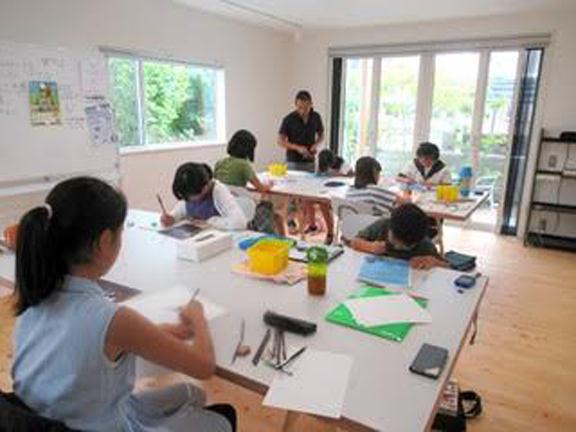


 by Geraldine Limpo
by Geraldine Limpo

The Asian Civilizations Museums in Singapore exhibits an exquisite porcelain from Qing Yongcheng’s reign. Stems of chrysanthemums rise from the base of the plate, its blossoms radiating their beauty along the cavetto; above these, butterflies flutter. This plate is not just beautiful; its creation is a potter’s triumph with managing high temperatures of the kiln in which the plate was baked twice—the first time to bake the clay and set the cobalt blue underglaze, and then a second time, to vitrify the enamels that account for the pinks and yellows. The composition is rich in symbolism. As the chrysanthemums bloom in autumn (considered a late season within a calendar year), it symbolizes to the Chinese the elderly scholarly gentlemen (literati). Butterflies symbolize heavenly blessings. Thus, it is conjectured that this decorative porcelain plate was given as a birthday gift to an elderly gentleman wishing him abundant favours.

Remembering this porcelain characterizes my state of mind every autumn—reflective and in search for beauty in the (metaphoric) sea of change we are in.
I recall starting a shojin ryouri course meal in Azabujuban with a recitation of a monk’s prayer that thanks, among many, the farmers who toiled in the fields that produce the vegetables being served to us that evening in a quiet private room for two. The prayer ended with a preparation of oneself to consume the various dishes plated lovingly in carefully selected ceramic and glass vessels, leaving me profoundly grateful, if not undeserving.

The red, yellow and brown maple leaves of Arashiyama come to mind too. Every autumn sighting in unforgettable Kyoto leaves me in awe and also makes me wonder how differently the autumnal panorama is from that of spring when the sakura blooms, and yet is equally breath-taking. Time brings change, and change, as these visual imageries evidence, can be heartwarmingly beautiful.
The pink, lilac and mauve colours of the fallen leaves in Maruyama-koen are just as vivid in my mind. Walking on a carpet of these in crisp November days reminds me how beauty is communicated as effectively in the lifeless.
I think of the fruits of the autumn too— the bright orange kaki and its sweet and mild flavour, the Aomori fuji, lime green ourin and juicy Jonagold, the koshu from Yamanashi (that the poet Matsuo Basho praised for its sweetness), the small seedless Delaware and the purple Pione grapes, the crisp nashi whose cultivation date back to Edo jidai (1603-1867) and its popular variety kosui.



Recently, I went home to Manila to attend a reunion with my dormmates in freshman year. In the few hours we spent together, I listened enthusiastically to life stories exchanged and celebrated, old songs played, sang and danced, 80s and 90s trivia quizzed. Life chastened and moulded us in the years following that freshman year in university, and somehow, it mattered little that I failed to recognize more than half of my dormmates, or that I knew so little of them even then. The homecoming sent me on a reverie very similar to my sensorial experiences of autumn. I encountered in that reunion beauty in warm re-introductions, enthusiastic attentiveness, random acts of kindness and hearty communal laughter.


 by Mae Grace
by Mae Grace


Autumn. The season of abundance, fruitfulness and plenty. It is the season of harvests and over brimmed baskets of fruits and pumpkins ripened to golden perfection. It is the time for budding and flowering even after summer is over, adding to the bees’ already overflowing honey cells. Autumn also means ‘thanksgiving’ when trees are ablaze with all the fiery colors of the sun.
My family has been blessed with a few autumn traditions that keep us looking forward to its coming year after year after year.
First in line would be the harvesting of the mandarin orange tree that our Ojiichan had planted years ago and that delights us always with fruits brimming from all its branches. Then it’s time for us to prune the tree after harvest and prepare it to take a little rest during the winter.

Autumn won’t be complete if we do not go “momijigari” or take a trip somewhere to appreciate the art of color watching, to places where autumn foliage could be gazed at and admired. One need not go out of Tokyo to do this. There are gems scattered all over the big capital of Japan, little pockets of gardens dedicated to preserving trees that many generations can enjoy and wonder at when autumn comes and visit. These photos were taken at Yonogayato Park located in Kokubunji City. Formerly owned by the founder of Mitsubishi Company until it was obtained by the Tokyo government, it has been turned into an oasis for the public to enjoy. Another must visit garden is the Jindai Botanical Park in Chofu City, a mere half-hour train ride away from the heart of Tokyo. If we consider how old these trees are, they were not planted only yesterday. They were fruits of a generation who loved autumn and had the vision to share the blazing beauty of autumn to the future generations. Autumn is fullness of life!



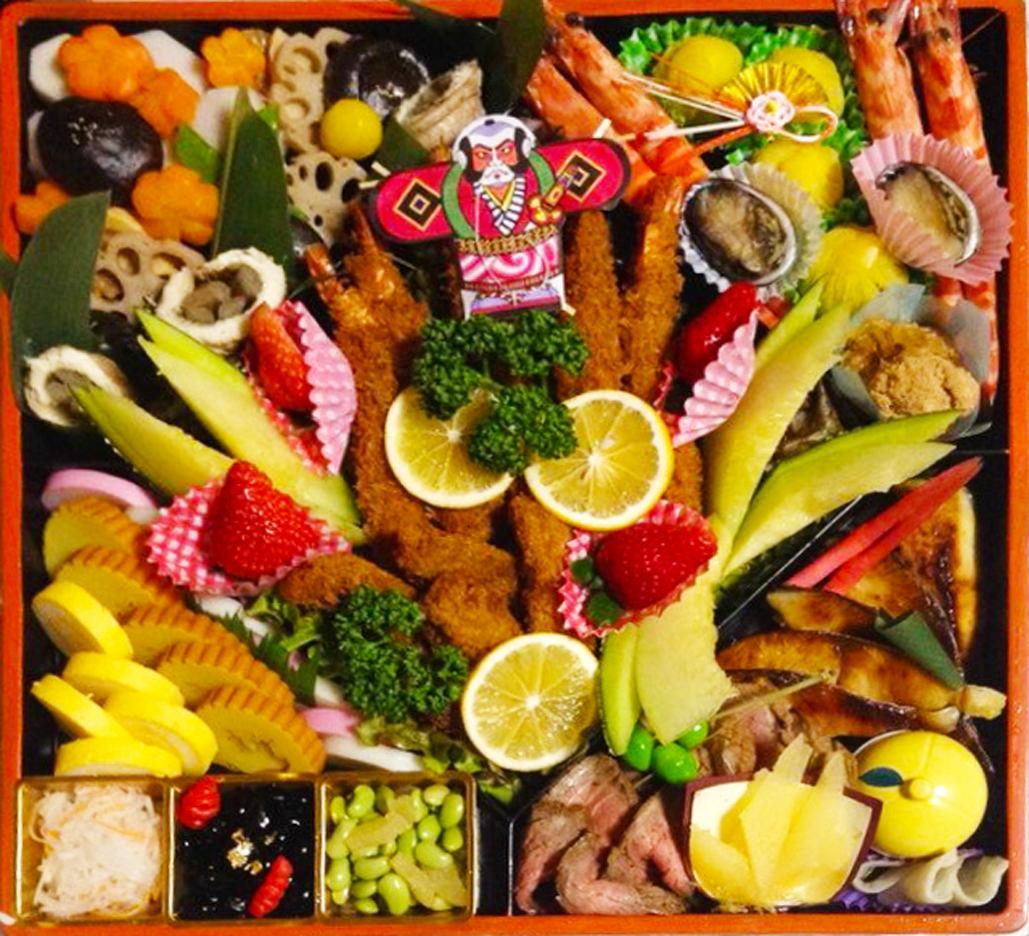
As early as October, you can see many advertisements selling O-sechi, a New Year special dish and a kind of preserved food enjoyed by family members during the New Year days. It also gives the Japanese housewives rest from the burden of cooking for the whole family during the holidays.
Nowadays, they are usually prepared and sold by restaurants, hotels and some other food shops. You can also buy them from famous department stores, but normally ordered in advance. Although, some housewives still prefer to prepare the O-sechi themselves.

Prices vary depending on the dishes that make up the O-sechi. The more luxurious ones may be sprinkled with some gold leaf on top of the dishes. There are many varieties and may include western dishes like shrimp fry, roast beef, or even boiled crabs and scallops. It may look like just some colorful and extravagant display of food to tickle your palate. But, each dish has a very significant symbolism. The usual main dishes that make up the O-sechi consist of:
• Datemaki, sweet rolled omelet mixed with fish paste or mashed shrimp. They symbolize many prosperous days. On lucky days (hare-no-hi), Japanese people traditionally wear fine clothing as a part of enjoying themselves. The scroll shape symbolizes intelligence and success in education.
• Kohaku Kamaboko, broiled fish cake. Traditionally, slices of red and white kamaboko are alternated in rows or arranged in a pattern. The color and shape symbolize the rising sun, and have a celebratory, festive meaning.
• Kazunoko, herring roe. Kazu means "number" and ko means "child." The fish eggs symbolize continuity of lineage by having numerous children.
• Konbu, kelp, which is a kind of seaweed. It is associated with the word yorokobu, meaning "joy."
• Kuromame, black soybeans. Mame also means "health," symbolizing health and hard work.
• Kohaku-namasu, literally "red-white vegetable" is made of radish and carrot cut into thin strips and pickled in sweetened vinegar with yuzu (Japanese lemon) flavor.
• Tazukuri, dried sardines cooked in soy sauce, which symbolizes abundant harvest. The kanji of tazukuri literally means "rice paddy maker," as the fish were used to fertilize rice fields from the olden times.
• Ebi, prawns cooked with sake (Japanese rice wine)and soy sauce. The round back symbolizes long-life.
• Nishiki tamago, silk brocade egg. The egg is separated before cooking, the yellow symbolizing gold, and the white symbolizing silver, both symbolize wealth and good fortune.
• Kurikinton, mashed sweet potatoes and chestnuts. The kanji literally means sweet chestnuts. The golden color symbolizes wealth.
I am personally not very fond of O-sechi, and I still prefer the taste of Western food. But, I think you should at least try them even once to find out the taste of each dish.
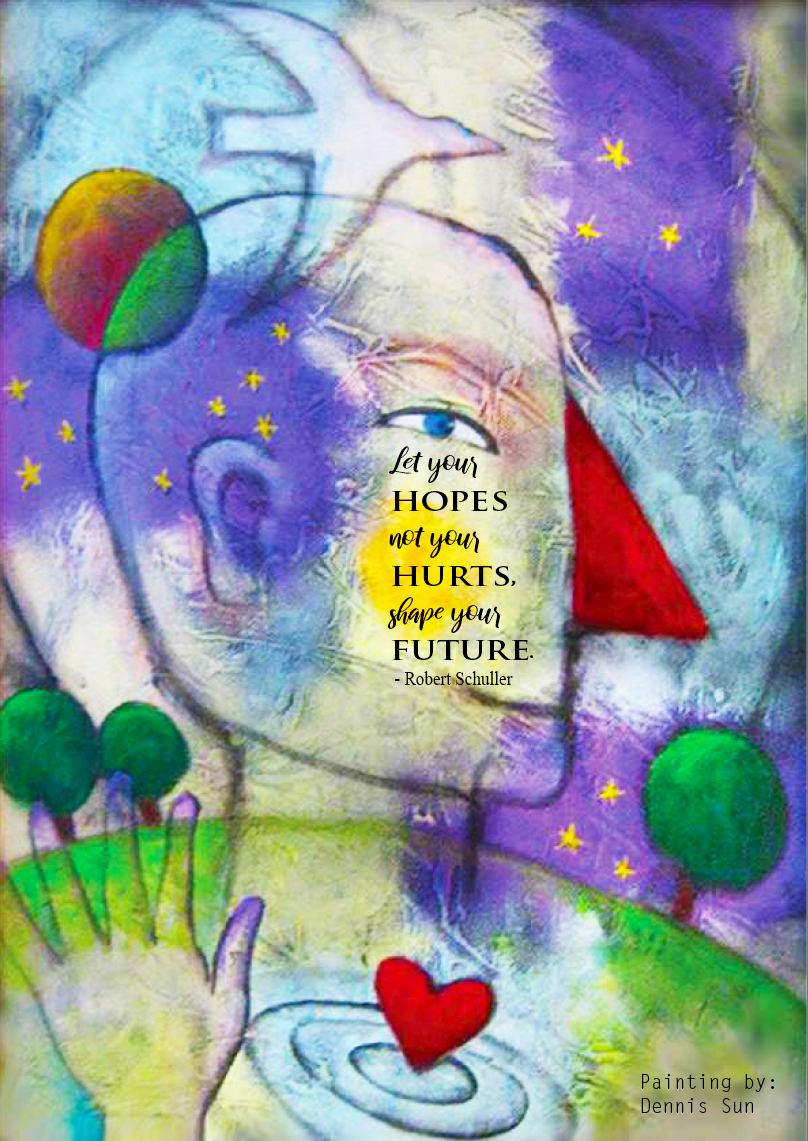


frequency is the number of times a wave repeats itself within a second.
Eyes closed, you remain still. Perhaps, you observe the rising and falling of your breath. Or simply, the darkness in front of your shut eyes. But wait, there are color hues, aren’t there? (Dang, you can see colors with your eyes wide shut!)
This was how the alpha brain wave frequency label came about. Salud to the volunteer meditator who sat as a guinea. Hence, to be in alpha is to simply be calm and relaxed. You are between 8 and 12 hertz (or Hz, or cycles per second). Creative people amass a wealth of alpha.
Beta brain wave was the next to be recorded by science. You - consciously doing the mundane to the most lofty, like reading this piece - are in beta brain wave freq. You are between 12.5 and 30 Hz.
So, you tried to continue your silent seated getaway, known as “me time” by experienced mindful meditators to the point that your body is already asleep (but your mind is awake). This is theta brain wave realm. Your neurons are slowly swirling in 3 to 8 Hz, according to empirical evidence.

Then usually, you fall into a deep dreamless sleep. Welcome to delta. Low and slow. 0.5 to 3 Hz.
A lot of interest is now being poured into gamma brain waves (almost akin to Bruce Banner’s gamma radiation rays). Why, you ask. They are the fastest brain waves in your brain. They measure above 35 Hz and can spike as high as 100 Hz. This is your brain firing in all cylinders. Full steam ahead! You are intensely focused. You have achieved peak concentration.
Briefly, I can name three ways for your brain to produce more gamma waves:
1] Mindfulness meditation (via the alpha wave route);

2] Acupuncture (shen ting and ben shen [bilateral]):
3] Eat pistachios (old folks almost got it right when they suggested peanuts).
By Marnie Chan #thehealingpowerofacupunctureAutumn in Japan has always been the most beautiful of the seasons. With its gorgeous fall foliage, perfect weather and an abundance of cozy comfort food, it’s easily the best time to explore Japan. But if the colorful leaves are not enough to keep your kids as excited as you for fall, here are some fun kid-friendly ways to enjoy this season.
Most Japanese go camping during summer, but early autumn is also an ideal time for this activity. Cooler weather means bugs have gone back into hiding and makes

Though not as popular as winter’s ichigo-gari (strawberry picking), fall fruit picking is another popular and kid-friendly activity.

Shizuoka-ken has their mikan-gari (orange picking), Yamanashi has budou-gari (grapes picking), and Funabashi in Chiba-ken has nashi-gari (pear picking).
Referred to here in
tents much more comfortable to sleep in. As autumn nights are also crisp and clear, you can also add stargazing as another activity with the kids. Yamanashi-ken has a lot of good camping sites, with some of the best ones situated right beside any of the Fuji Five Lakes.
Japan as autumn’s cherry blossoms, cosmos flowers are in full bloom during this season. Showa Kinen Park, known for its gingko trees and autumn foliage, also draws a crowd for its colorful cosmos fields.

"I wake up every morning with a great desire to live joyfully."
—AnnaHowardShaw
"I wake up every morning with a great desire to live joyfully."

EVERY GISING IS A BLESSING TO ALL!
Mga Kuwento ni Nanay na po tayo. Jeepney Press na po tayo. SAKAY NA PO KAYO!
PINAS… PINAS… PINAS… SAKAY NA PO!
November na po. Tapos na Halloween, All Saints Day & All Souls Day! Malapit na po ang December! CHRISTMAS na po! Ang bilis ng araw!
Do you believe that there is life after this life? Do you believe there’s heaven? Naniniwala po ba kayo na meron LANGIT? Meron akong kuwento tungkol sa isang babae na nag-asawa nang pitong 7 beses. Tanong: Sino ang masasalubong niya sa langit sa pitong asawa niya pag namayapa na siya?
First Moments in Heaven. O, ang unang una natin makakaharap ay ang DIYOS. ITO ANG UNANG PINAKAMALIGAYA NATING PAGHAHARAP SA ATING LUMIKHA. KASAMA ANG ATING MGA MAGULANG AT ANG ATING BUONG PAMILYA. Kung isa sa ating miyembro nang ating PAMILYA ay hindi nakarating dahil nawili siya sa mga kamunduhang yaman at mga bagay. Nakakalungkot ito para sa kanya.
HEAVEN IS REAL. Sabi nga ANG LANGIT AY TUTUO. DECIDE TO GO TO HEAVEN. I WANT TO BE UNITED WITH YOU LORD. LET US SEARCH & STRIVE TO GO TO HEAVEN. Gawin natin ang lahat upang makarating sa langit. Marami itong pagsubok bago tayo makarating sa langit. WE WILL
ENCOUNTER A LOT OF STRUGGLES. BE AGENTS OF HEAVEN NOW. SPREAD JOY. MAKE HEAVEN NOW.
LESSON… SELFISH PEOPLE GO TO HELL. DON’T GIVE HELL TO YOUR LOVE ONES BY SHOUTING and always ANGRY. Kung palagi tayong naka sigaw at galit, para natin binibigay sa kanila ang impyernong buhay, di po ba? HOW MANY ENCOUNTER HEAVEN IN POVERTY? By being joyful, we ease the burdens, no more pain. ASK GOD TO BLESS OUR DESIRES TO GO TO HEAVEN.
PLEASE MAKE ME HEAVEN TO HAPPEN NOW. BE GRATEFUL. DO NOT COMPLAIN, COMPLAIN AND COMPLAIN. Example, reklamo tayo nang reklamo na pagising mo magliligpit ka pa nang futong (yon higaan po dito sa Japan). Sa gabi, reklamo ka nanaman dahil hindi ka matutulog kung hindi mo ilalatag ang iyong futon. Pero kahit puro ka reklamo nailatag ba yong futong mo? Hindi ba ikaw pa rin ang maglalatag. Kaya matutulog ka na lang buwisit ka pa. Mahiga ka na lang. Wala nagawa ang puros reklamo mo, di po ba?

PRAY FOR OTHERS NOT ONLY FOR OURSELVES. PURIFICATION, THANKSGIVING IN OUR OWN WAY, REPARATION, TOO. OUR DATE TO ETERNITY. MAKING HEAVEN HAPPEN TO ALL OF US.
See you all in heaven not now yet but after our mission.
“HINDI MO KAILANGAN MAGING MAYAMAN O MATAAS NA PINAGARALAN UPANG MAKATULONG SA KAPWA MO PILIPINO”

Maligaya at malamig na buwan ng Pasko mga kababayan! Nawa ay nasa mabuti po tayong kalagayan at ligtas sa anumang karamdaman.
Paano kaya ang ating Pasko ngayong nagmahalan ang mga bilihin at bumaba ang halaga ng ating Japanese yen? Dahil dito, lumiit na din ang halaga ng ipinapadala natin. Hindi lang dito tumaas ang halaga ng bilihin kundi maging sa atin ay halos lahat nagrereklamo dahil ultimo gulay maging sa mga probinsya ay nagmahal na din. At ang tanging magagawa natin dito ay magsikap at magsipag dahil wala naman talagang ibang makakatulong sa ating mga sarili kundi ang ating mga sarili mismo. Hindi po ba?
Paano na din kaya ang Pasko ng mga kababayan nating nasalanta ng bagyo? Kasing lamig din kaya ng Pasko natin dito sa Japan? Kung saan parang hindi natin masyado ito nararamdaman. Na para bang ordinaryong araw na lamang ito at hindi katulad ng Pasko natin sa Pinas na pagdating ng Oktubre ay makakarinig ka ng mga masisiglang awitin sa kabila ng samo’t-saring suliranin o pagsubok na ating kinakaharap. At hindi lingid sa ating lahat na ang Pasko sa Pinas ay talagang inaabangan at mas gugustuhin sana nating doon magpasko para makasama ang mga mahal natin sa buhay at siempre dahil talaga namang kakaiba ang Pasko sa atin. Maraming Santa Claus pa ring iikot at magpaparamdam at kahit papano ay marami pa rin ang magbabalot ng mga regalo at makakatanggap ng mga ito.
Ilang Pasko na din na may Covid at
mukhang nasanay na din tayo sa “social distancing” kung saan malamang hindi na ulit natin ito maidaos ng magkakasama lalo na dito sa mga “kaisha” na may “bonenkai” at “shinnenkai” dahil na din sa lalo pa ring tumataas ang kaso ng Covid dito sa Japan ngayon at upang makaiwas sa pagkakahawa-hawa kung sakali man. Nakakalungkot pero wala tayong magagawa at upang maipagpatuloy ang buhay natin kailangan din natin itong gawin para sa kapakanan din ng lahat. Higit sa lahat kailangan din nating ingatan ang ating mga sarili dahil dito sa Japan, masiglang pangangatawan ang ating mga puhunan dahil kahit na medyo apektado ang ekonomiya ng bansa, marami-rami pa rin naman tayong mahahanap na trabaho. Makakaraos at makakapagpadala pa rin tayo sa ating mga pamilya sa Pilipinas kahit papaano.
Kaya sa anumang pagsubok na ating nararanasan, lagi po nating tatandaan na ang lahat ng iyon ay may dahilan. At lahat ng katanungang “paano” ay may kaukulang kasagutan at pamamaraan upang ito ay ating makayanan at malalagpasan. Huwag din po nating kalimutang magdasal at humingi ng gabay sa Diyos Amang Maylikha sa atin dahil tanging sa Kanya lamang ay walang bagay na imposible.
Hanggang sa muli po. Maligaya at Mapagpalang Pasko po sa lahat.

Be brave enough to find your life As morning comes and we wake up Every day is the gift we can have A chance we must take and not to give up
Life is about changing as every second counts Make all your best as you can Save all the best you can And give all the best you can We can’t change what we’ve done We can’t get back things that’s already gone But we can hold on for our own reasons And stay with our goals and directions
Starting over again is the best thing to do Forget everything and appreciate it happened


This kind of sickness must be treated right away. It is not only an issue of your mood but a biological illness of your entire body.
Ang sakit na ito ay malubhang kondisyon na maaaring paikliin ang iyong buhay, ngunit magagamot din ito.
Ang bawat tao'y nakakaramdam ng kalungkutan minsan. Ang pagkasira ng isang relasyon o isang masamang marka ay maaaring humantong sa mababang mood. Minsan dumarating ang kalungkutan sa hindi malamang dahilan. Mayroon bang anumang pagkakaiba sa pagitan ng mga nagbabagong mood na ito at kung ano ang tinatawag na depresyon? Ang sinumang nakaranas ng isang episode ng depresyon ay malamang na sumagot ng oo. Ang depresyon, kumpara sa karaniwang kalungkutan, ay nailalarawan sa pamamagitan ng mas mahaba at mas malalim na mga damdamin ng kawalang-pag-asa at pagkakaroon ng ilang partikular na sintomas. Ang pagkakaibang ito ay mahalaga, dahil sa mga malalang kaso, ang depresyon ay maaaring maging banta sa buhay, na may pagpapakamatay bilang isang posibleng resulta. Ang mga taong nalulumbay ay maaari ring mabigo na mamuhay ayon sa kanilang potensyal, hindi maganda ang ginagawa sa paaralan at manatili sa mga social margin. Ang depresyon ay madalas na binabalewala o hindi ginagamot; madalas na pinipigilan ng kondisyon ang mga tao na gumawa ng mga hakbang upang tulungan ang kanilang sarili.
Ang hindi ginagamot na depresyon ay nagdaragdag ng pagkakataon ng mga mapanganib na pag-uugali tulad ng pagkagumon sa droga o alkohol.
Maaari rin itong makasira ng mga relasyon, magdulot ng mga problema sa trabaho, at maging mahirap na malampasan ang mga malubhang sakit.
Kamakailan lamang may isa na namang Pinay na ating kababayan ang kinitil ang sariling buhay dahil sa depresyon. Hindi na kinaya lahat ng dagok at pag-subok sa buhay, namatay dahil sa depression. Masarap pang mabuhay ng mahaba, may pag-asa pa upang maiba ang takbo ng ating buhay. Kailangan mo lamang paglabanan yung mga bagay bagay na negative na dumarating, lumayo ka sa mga taong palaging negatibo ang epekto sa buhay mo.
Lumabas ka, go out with your friends upang malibang ka, at hindi buong maghapon palagi mo inisiip yung mga problema. Katulad ko, minsan din dumating ako sa point na ganyan na halos gusto ko na magpakamatay, pero nilabanan ko. Nagdasal ako ng nagdasal na samahan ako ni Jesus sa lahat ng pagkakataon. May mga time na feeling ko walang nagmamahal sa akin, pero dahil nilalabanan ko ang ganitong feeling iniisip ko na andyan si Jesus na kahit kailan hindi ako iiwan. Sa kanya ipinagkakatiwala ang lahat. Dahil pag si Jesus ang nangako sa atin, never nya tayo bibiguin. Tapat sya kahit kailan. Isa sa mga Tips, mga kapatid, kapag ikaw ay nakakaramdam ng kahit na anong pag aalala sa buhay, makinig ka lang ng mga worship songs, tiyak na gagaan at luluwang iyong pakiramdam.
Favorite kong worship song pag feeling down ako, pwede nyo syang hanapin sa You Tube.
https://youtu.be/muxNziVFoYg Sobrang ganda ng awit na ito sana makatulong kahit paano.
”TAPAT KAILAN PA MAN”
SA PANGINOONG HESUS, AKO NAGTITIWALA SA BIYAYA NIYA'T HABANG BUHAY KO AY MAY KALINGA SA PAGSUBOK AT LUMBAY NARO'N SYA'T DUMARAMAY ANG PANGIN0O'Y TAPAT KAILAN PA MAN KUNG IKA'Y NANLALAMIG, WALA KANG MALAPITAN PARA BANG ANG DAIGDIG SA IYO'Y NAKAPASAN ALALAHANIN MO SANA, MINAMAHAL KA NIYA ANG PANGINOO'Y TAPAT KAILAN PA MAN BIYAYA NIYA'T HABAG SA BUHAY KO'Y

SAPAT DI MAN KARAPATDAPAT, AKO AY NILIGTAS
PANGAKO NIYA'Y DI NAG-IIBA DI TULAD NG IBA ANG PANGINOO'Y TAPAT KAILAN PA MAN
In this age of Tiktok and short attention span, how do we really measure the success of an advocacy? As often true with commercial undertakings, people are usually focused only on what they can readily measure – headcount, ticket sales, and sometimes, the number of heart emojis in a social media post. Pero paano nga ba sinusukat ang tagumpay ng isang pakikibaka? How do we even measure a movie’s impact and long-term influence? How do we gauge a student or an academic’s capacity to pass forward learnings beyond the movie house? Paano ba natin bibilangin ang mga
matang namulat at mga diwang nagising?
When Angat Pinoy Japan, in collaboration with Ms. Menchie Mizuno of Engage, thought of bringing the movie Katips to Tokyo, we only have one goal in mind, to


educate as many Filipinos as possible about Martial Law years, the dark side of our history. We thought it was very timely, considering that this year we are commemorating the 50th year since it was proclaimed in 1972. Ano na nga ba ang natutunan natin bilang isang bansa sa madilim na nakaraang pilit ding binubura ng iilan?
Meet and greet, October 13, 2022, Thursday. The Katips cast were warmly welcomed by our kababayans with a full house meet and greet. Business owners, members of the academe, members of the Association of Filipino Students in Japan (AFSJ), Migrante Japan and Magdalo Japan where among the groups that participated in the
lively discussion about the movie and life during the martial law era. Prof. Nathan Quimpo’s (brother of Martial Law victim and one of the main characters in the movie, Ishmael Quimpo) sharing about his own family’s experiences was very enlightening.


Screenings in Urawa, Saitama and Tokyo University of Foreign Studies, October 15 and 16, 2022. The Katips cast graced the screenings scheduled in Urawa, Saitama and Tokyo University of Foreign Studies (TUFS) in Fuchu, Tokyo. The Director, Atty. Vince Tanada shared his inspiration and answered questions about the film. Mr. Takushi Ohno,
a journalist, delivered his critique of the movie and shared his personal experiences as a foreign student in the Philippines during the Martial Law era. The TUFS open forum was very enriching and at the same time an eye-opener given the number of Japanese students and non-Filipinos who participated in the discussion about Philippine history.
Kung tatanungin muli, paano nga ba sinusukat ang tagumpay ng isang pakikibaka? Kung ang basehan ay ang mga manonood na umuwing puno ng kaalaman at inspirasyon bunga ng pelikula at mga diskusyon pagkatapos nito, oo naging matagumpay tayo sa adhikaing ito.

When the “Beaver Moon” made a grand appearance in the sky on Nov. 8th, I was one of those awed by this phenomenon that happened after 472 years. Its mystifying effect was in perfect timing with the best-loved season in Japan, Autumn. As the moonbeams smile on the Momoji (maple trees), it adds a touch of regality and serenity to the air.
although there were multiple thrills along the way as the skilled boatmen negotiated through the narrow rock formations, the reactions were subdued compared to the gasps and shrieks of tourists in the Philippines or elsewhere. This famous tourist attraction, the Hozugawa was
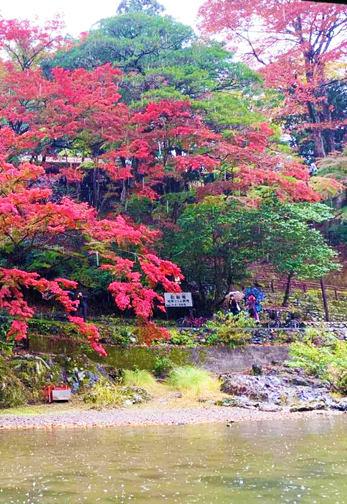
Viewing the autumn foliage is another tradition of the Japanese given as much importance as Cherry Blossoms Viewing in Spring. I am much obliged indeed to the head of our department and his wife, Makoto and Naomi Imashioya, for inviting me to join them on an exhilarating Hozugawa boat ride in Kyoto that reminded me of “Shooting the Rapids“ in Pagsanjan. The only difference was that


described in Natsumi Soseki’s “Gubijinso” in 1991. It was also visited by many foreign dignitaries, like the Prince of Wales in 1992.
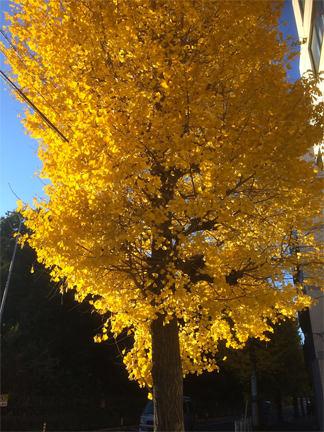
What caught my fancy was a small Ginkgo tree (Maidentree ) or Ichio. Its origin is in China which dates back 270 million years ago. A living fossil with a strong defense mechanism is called “Yinguo” in Mandarin and Ngan-Gwo in Cantonese. Engelbert Kaempfer misspelled it in his book as Ginkgo instead of Ginkyo, so it was never corrected. The fruit is called gin nan and the seed is cooked for chawan mushi.
Due to the atomic bombing in Hiroshima, six varieties of this tree were called the Hibakujumoku, meaning “trees that survived the blast.“ We sat on the tatami mats of the Tenryu-ji Temple, (Temple of the Heavenly Dragon) as we savor the view of the beautiful Arashi Mountain from the Sogenchi Garden, a World Cultural Heritage Site. I saw more Ginkyo trees and their yellow color was enough to brighten up our spirits. Its symbol of resiliency inspired Mr. Ikko Tanaka to design the logo of Osaka University in 1991 in the shape of the ginkgo leaf to commemorate its 60th anniversary.
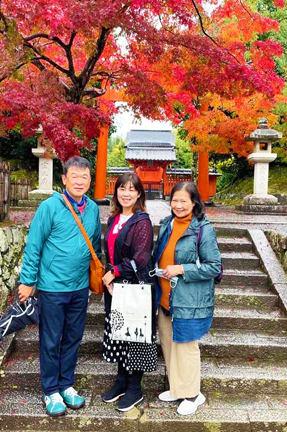

We ended our day with a ride on the Torokko passing by the same Hozugawa Kudari and as I saw that Christmas tree-shaped Ginkgo tree again, I thought of Christmas in a much different color, tone, and perspective.
Maligayang Pasko at Masaganang Bagong Taon sa lahat ng mambabasa ng Jeepney Press!
(photo credits to Mr. and Mrs. Makoto and Naomi Imashioya, Owie Sarmiento, and Joey Manalang)
This year is very special for me. I received the best gifts ever, for my Nov. 8 birthday.
An advance birthday gift, for being given the chance to join the 2022 18th Summit of Filipina Women’s Network held in Lisbon, Portugal last Oct. 30 - Nov. 4, and a belated one, for being chosen 2022 University of the Philippines’ (UP) Outstanding Alumna for Banking and Corporate Social Responsibility, with dinner hosted by the UP President on Nov. 9, and the presentation of the award on Nov. 11 by the UP Alumni Association (UPAA).
The latter is the most valuable gift for me, as it tops all previous awards, citations, and recognitions I have received during the 69 years of my lifetime. I owe this to my Ima and Deng, to my first-year school adviser, now Medical Mission sister Carmelita Perez, to UP Sigma Alpha Sorority, which nominated me for the award, to you, my readers, and
my co-OFWs, and most of all, to God who has never failed to guide me through my ups and downs, and who always holds my hand to help me stand up when I fall.
There were three (3) things I wanted to accomplish in Lisbon: 1. Do my Global Pitch on the Deployment of Nurses and Caregivers in
Japan, to the USA and other English-speaking first-world countries like Canada and Australia;
2. Attend the book launching of “Being”, the 4th FWN leadership book where I am one of the authors (I was also an author in the first leadership book Disrupt, Filipina Women: Proud. Loud. Leading Without A doubt, and the title of my chapter was Japan: A Love-Hate Relationship).
3. Give moral support to my two (2) nominees for FWN Global 100 Most Influential Women in the World Award who made it to the awarding, Elena C. Tesoro, PhD., and Prof. Grace Gorospe Jamon, PhD. (Note: I was in
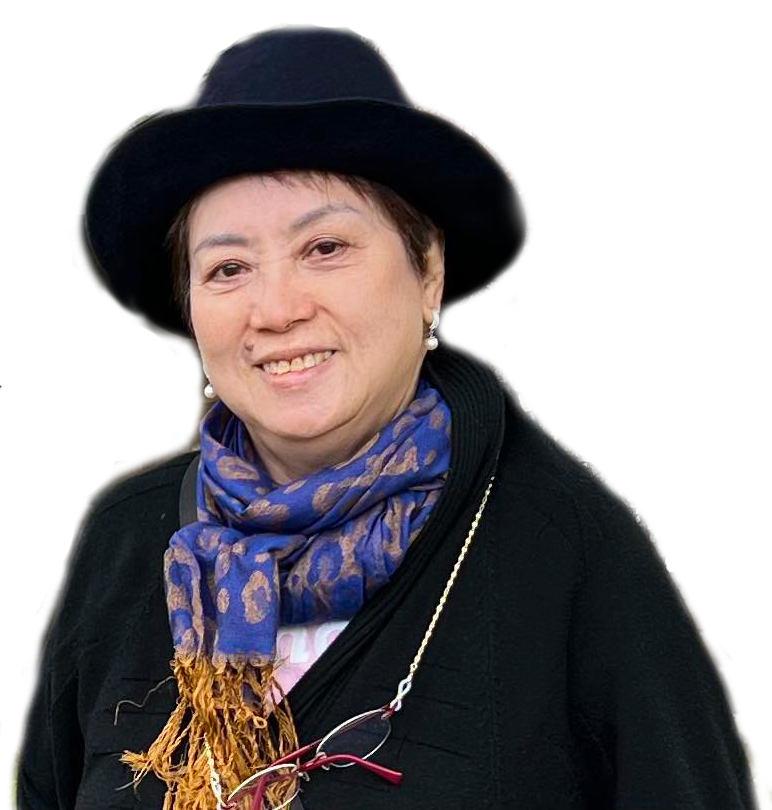
the first batch of Global 100 Most Influential Filipina Women, awarded in San Francisco, USA. The Philippine Embassy in Tokyo was the one who nominated me for the award).
I am hoping that my Global Pitch will produce concrete results. The audience was composed of FWN’s Most Influential Filipina Women in the World awardees from more than 36 countries in various fields of endeavor –medical, immigration law, politics, etc. Surely, there is a big chance of finding the right partner to assist our nurses/trainees who enter Japan basically as “trainees” for 3 years and have to pass the language proficiency exam before the end of their 3-year visa, lest they be sent back home. I want to be able to offer them another chance at continued employment.
My chapter in the book Being is titled “Just Me, Lita’s Mother”. It is a tribute to the love of a mother for her daughter, her sacrifices for years, and her suffering quietly when her daughter is in pain. It is based on a letter I discovered in my Ima’s attic when she was already very sick. Unfortunately, she did not see the book come to print as she passed away last April 30, 2022. I also failed to thank her for her deep love for me, as evidenced by that hand-written letter, before she finally joined her creator. (Note: All the FWN leadership books, including
“Being” can be ordered thru Amazon.com).
To Elena and Grace, I now pass on to you the responsibility to continue searching for a Filipina leader in every sector of the world economy, but most especially, from our province in Pampanga where there may be other Filipina leaders who remain undiscovered and unrecognized.
2022 University of the Philippines’ Outstanding Alumna in the field of Banking and Corporate Social Responsibility.
Dennis Sun/Jeepney Press was one of several who was requested by UP Sigma Alpha Sorority to write a recommendation letter to strengthen the sorority’s nomination of myself. Cesar Santoyo of SEELS academy was another one from Japan who wrote glowing praise for the work I have done during my at least 30 years of working with OFWs, particularly women, in Japan. Thank you, Tito Dennis and Ka Cesar. Others are the Editor of the FWN leadership books; a top businessman who is one of the 40 richest in the Philippines, and my former PNB Chairman.
When I first received a call from the UP Sigma Alpha Sorority that they want to nominate me, I initially refused. The sorority has a sterling record of three (3)
consecutive years of bagging the award in various categories. I thought I am not worthy of their trust and confidence, and I might break the sorority’s record if I do not get chosen. I was told people will do their best to get some organization/institution to nominate them, and here I am, refusing the chance. And so I agree, and the rest is history.
I should not fail to mention here that my Dear Tita Lits advice column to our Japan OFWs (“femtoring”, as FWN calls it) was mentioned and highlighted among my services to our OFWs. Thank you very much mga ka-OFWs. Salamat din for paying my salary (indirectly) when I worked as head of PNB for Asia and the Pacific and also for Europe, Israel, and Africa based in Tokyo and Rome, respectively. I continue to thank you for your patronage of Speed Money Transfer Japan K.K. which, is now my employer.

Just continue dreaming; work very hard; do not give up; take any good opportunities to improve your education, your career; pray hard.
We can make it!
Love, Tita Lits
Lita explaining her chapter in the 4th FWN leadership book, "Being".


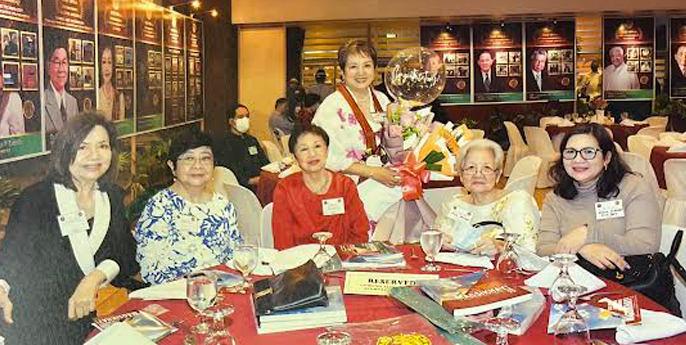
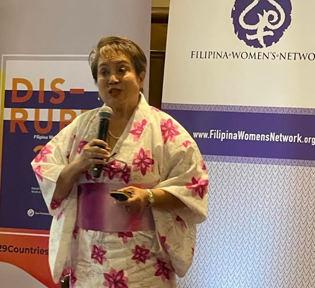
Lita during the launching and book reading of "Being", held at the Germio Literario, Lisbon.
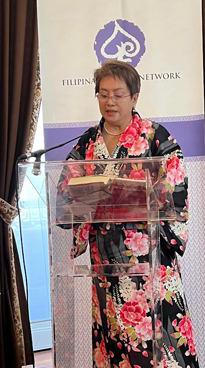
Lita giving her Global Pitch on Deployment of Nurses & Caregivers in Japan, to the USA.
Francis "Kiko" N. Pangilinan, AB'88; LLB'93 was one of the awardees (Public Service). On his left is Senen S. Perlada, BSBE'78, also an awardee (Public Service and Good Governance for Development Promotion

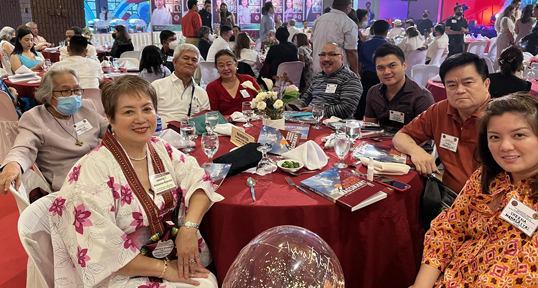

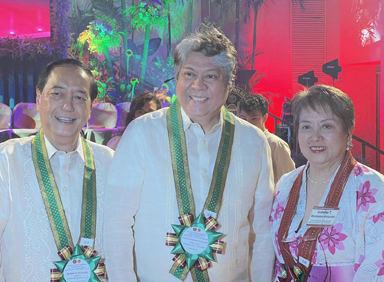
My only son JC was my escort to the dinner hosted by UP President Concepcion for Outstanding Alumna awardees on Nov. 9, 2022 at Bahay ng Alumni, UP Diliman.
